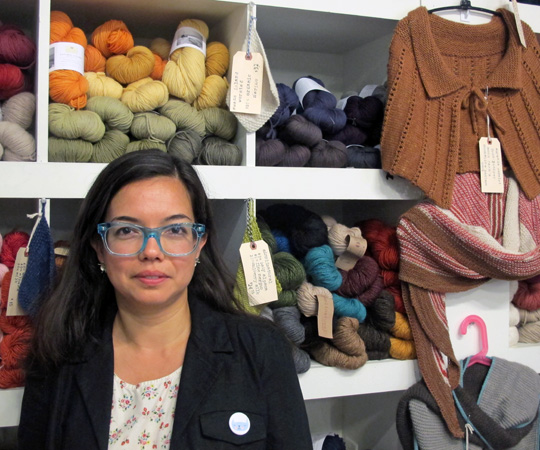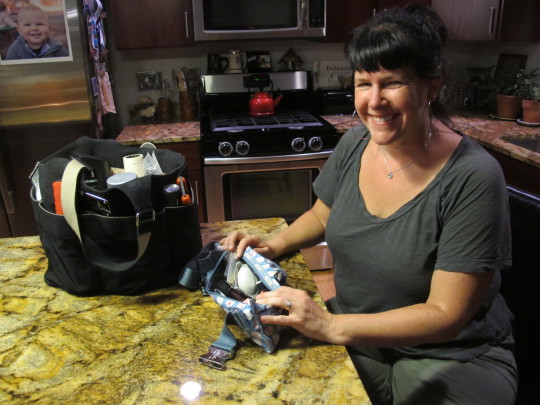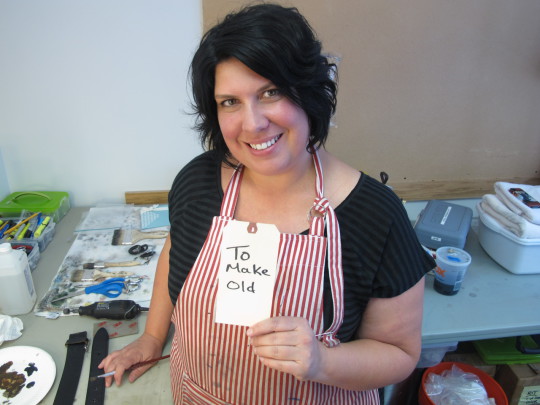By Adrea Shea
WBUR
August 19, 2014
BOSTON — We recently reported on the growing film crew base in Massachusetts — the gaffers, sound men and costumers who live local but are finding steady work on Hollywood movies shooting here.
Now let’s go deeper into one of the creative areas in the filmmaking ecosystem, the costume department, where professionals work long hours day after day, taking meticulous care to create wardrobes for films like “The Social Network,” “American Hustle” and “Black Mass.”

Costumer supervisor Virginia Johnson inside her yarn and crafting supplies store Gather Here and Make Something (Andrea Shea/WBUR)
In December Virginia Johnson can focus her attention on running Gather Here, a yarn and crafting store she owns in Cambridge. But when filmmaking season starts gearing up a few months into winter, she goes into something of a production black hole, for weeks at a time, as a costume designer or supervisor.
“It’s pretty crazy,” Johnson admitted, adding that she warns friends and family that when she’s working on a film she’ll likely be incommunicado.
In the role of costume supervisor she said people often assume she gets to sew all of the time.
“And I have to tell them I actually spend a lot of time on a computer, because I’m one of the first people on who breaks down the script,” she said.
Johnson analyzes every scene and character so she can predict how much clothing will be needed for the filming. Then her team of tailors, stitchers, costumers, production assistants and shoppers gets to work. The buyers hit local vintage stores and Goodwills to search for everything from beat-up belts to platform shoes to those iconic sweatshirts Mark Zuckerberg’s character wore in “The Social Network.”
“People don’t think of it as period, but it actually is if you think about those early 2000s,” Johnson said, “and so we did a lot of vintage shopping and had stock that was coming in from Los Angeles.”
But they couldn’t find the exact sweatshirt, so Johnson asked her tailor to recreate them.
“We’re storytellers in everything we do. How we’re dressing people just enhances the story and helps you take that journey,” she explained.

Jesse Eisenberg, left, and Joseph Mazzello are shown in a scene from “The Social Network.” (Columbia Pictures, Merrick Morton/AP)
Johnson just wrapped the Whitey Bulger biopic “Black Mass,” and she says everyone in that costume department lives locally except for the costume director and costume designer.
“We all have really specific tasks, and we do it really well,” Johnson said. “And if you don’t fill those roles and have people who are really good in those roles, then the system falls apart.”
One of the people Johnson has relied for a number of films, including the lacrosse film “Crooked Arrows,” is key costumer Honah Lee Milne. When asked to describe her involvement with (potentially) thousands of pieces of clothing, she said, “You know, we set them in the morning, we set them per each change, we have to clean them, we have to make sure that everything looks the way it supposed to look.”
In the film business everything needs to look perfect for every single shot. That could mean perfectly pressed, grungy, bloody or ripped. This is incredibly challenging because films are almost always shot out of sequence.
For example, if Johnny Depp is wearing a shirt for a scene one day that has three buttons undone and a coffee stain on his lapel, Milne and Johnson are responsible for ensuring those same three buttons are open when they pick up the scene the following day. This is called continuity, and Milne says the department is obsessed with it.
“Everything gets bagged and tagged with the scene number, the character’s number. We keep a continuity book of how they wore the clothes, what the clothing was, its label, brand, etc.” she explained. “It’s a very detailed process of what we do to track that clothing.”
Now they’re using a new locally designed app that catalogs all of that into a shared database. Even so Milne says every day on set is a gauntlet of problem solving — and she relishes it.
“When somebody says, ‘Hey, my zipper broke,’ you’re like, ‘What kind of break do you mean? What’s the situation here? Do I need to zipper wax it? Do I need to put a whole new zipper in? Can we rig it somehow? Can I sew you into that? How can we make this work?’ ”
Milne has posed this question to actors on “Moonrise Kingdom,” “Captain Phillips,” “R.I.P.D.,” and she is currently working on “Ted 2.” She unzipped one of her two costumer’s kits that’s packed with tools and remedies.
“This is my fanny pack,” she said with a laugh. “So what’s in here, let’s see? There’s a camera. Top stick, which is double-sided tape. A piece of fur from Jen Lawrence’s coat on ‘Hustle’ that I shoved in there. Many, many stain removers, some hair spray, some shaving cream — shaving cream takes out fake blood.”
If Milne can’t conquer the fake blood — or when the on-set laundry she manages doesn’t suffice — supervisor Johnson turns to another local professional.
“I mean I’ve used the same dry cleaner for the last seven years on every single movie,” she said.
His name is Farshad Sayan, and he owns Clevergreen Cleaners, based in Medford. Sayan told me he took in 4,000 to 5,000 pieces of clothing from “Black Mass.” The bill was approximately $40,000. But he said not all of the films bring in that kind of cash.
“I can count the big accounts probably on one hand: ‘Knight and Day’ with Tom Cruise and Cameron Diaz, that was a big-budget movie that we did. ‘R.I.P.D.’ was OK. It wasn’t that great.”
Last year he handled “American Hustle.” “That was a big-budget movie,” he said.

Farshad Sayan, a dry cleaner who owns Clevergreen Cleaners, has been working on movie wardrobes with Virginia Johnson for the last seven years. (Andrea Shea/WBUR)
Sayan says he’s worked for more than 40 movies. One wall in his Medford store is covered with autographed photographs of stars, but he believes people like Johnson in the costume department deserve more credit.
“Some of them are so meticulous,” he said, “and the one thing that I have learned is I cannot have access to how much pressure they’re under. And when I think I have pressure in my job, and then I see what they go through in the short span of time and what they’re accountable for, it just gives a whole new perspective.”
There’s one artist on Johnson’s “Black Mass” team that does something I didn’t even know existed until now. Her title is ager-dyer.
“I will throw her a leather coat,” Johnson explained, “then I say, ‘This needs to look 10 years older and exactly like this leather coat that we found in this vintage store that we already used. Paint it, crackle it, do whatever you have to do to soften it up, but I’m going to use it on a photo double tomorrow.’ ”
“The first thing I did was take a belt sander to it,” ager/dyer Jill Thibeau recalled with a laugh. “Then I think I put it in the washing machine. I’ve definitely beaten up some beautiful clothing.”
For “R.I.P.D.,” Thibeau shredded a $2,500 Italian suit. On the day I visited her work space at the “Black Mass” production offices, her assignment — which Johnson wrote in black Sharpie marker on a ubiquitous wardrobe tag — simply read, “To Make Old.”
“Most of what I do is just invisible,” Thibeau said as she rubbed a new black leather belt back and forth on a work table with the heel of her hand. “I do a lot of belts and a lot of shoes. You know these are things you’ll never notice in the movie. But they’re things that just set the atmosphere.”
One of Thibeau’s favorite tools is a dremel — a small, handheld, drill-like gadget – which she uses to soften edges on new things. As she sees it, she’s giving these items character and life.
On her desk sits a few labeled bottles filled with grimy liquid. She concocts her own blends to replicate varieties of dirt for different locales, including a Southie grime mix called “Black Mass” to brush on shoes or on the bottom of pants.
“Things that might just sort of hit the street as you walk every day,” Thibeau mused.
She also worked with two other ager/dyers on “Captain Phillips” where they had to conjure the color of the earth in Somalia.
Everything Thibeau does is hand work. None is digitally replicated. She knows full-well that her job is pretty unique.
“It’s a really tight niche,” she explained, “and I feel really lucky because it didn’t exist in Boston. I’ve been trying to carve out this role at a glacial pace over the last few years.”
Thibeau went to school for textiles at the Rhode Island School of Design and teaches at MassArt during the offseason. She says recreating ring-around-the-color and sweat stains on shirts worn by actors playing drug dealers is absolutely fulfilling.
“It’s really kind of odd, actually, that I’m just sitting in here working on spraying clothes. I’m kind of recreating the texture of drugs dealers and low-lifes,” she said, laughing. “It is interesting.”
Honah Lee Milne said the same about her job as key costumer.
“Everyday I’m like, ‘I’m going to work again, and this is so awesome that I get to go make a movie’ — and then in a year I get to go see it, and go, ‘All right, did I do a good job? Is that guy’s collar right?’ ”

